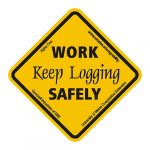Back Health for Loggers
by Brie Weisman, Occupational Therapist with Maine LogAbility. Article published in the Fall 2021 Logger’s Voice (Volume 15, Issue 4)
Low back pain is one of the leading causes of disability, occurring in similar proportions in all cultures, interfering with the quality of life, and the ability to earn a living.
 Logging is a physically demanding, dangerous job that is repetitive, mechanically jarring, and takes place on terrain that is often uneven, steep, and slippery. These conditions cause loggers to be at an increased risk for lower back pain or back injury due to overuse, sudden wrenching, or impact injuries from falls and accidents. Even those loggers remaining “safely” seated within vehicles for the workday are not immune from a lower back injury. Staying seated for prolonged periods in a vehicle or machine is a common cause of lower back pain—ask any trucker.
Logging is a physically demanding, dangerous job that is repetitive, mechanically jarring, and takes place on terrain that is often uneven, steep, and slippery. These conditions cause loggers to be at an increased risk for lower back pain or back injury due to overuse, sudden wrenching, or impact injuries from falls and accidents. Even those loggers remaining “safely” seated within vehicles for the workday are not immune from a lower back injury. Staying seated for prolonged periods in a vehicle or machine is a common cause of lower back pain—ask any trucker.
Although it is easy enough to see how work accidents cause back injuries, the cumulative nature of a long career in the industry is more often the source of back injuries in logging. There are simple, effective techniques to address back pain that take very little time or money.
- Limit bending, twisting, and lifting. Elevate work space, when feasible, to reduce bending and keep the back as straight as possible. Instead of twisting to do a task, face the item with feet pointed in the direction of the task. Install swivel seats in equipment; select a seat that can easily be locked in place.
Avoid lifting heavy items, when possible, by sliding or dragging them along or using a wheelbarrow, cart, or mechanical advantage. When lifting use proper posture and technique. Protect your back muscles by squatting with a straight posture and lifting with your legs, holding items close to your chest. Instead of carrying heavy gear by hand for long distances use a backpack. There are external frames designed to carry hard-cased toolboxes, or the backpack frames can be modified to carry bulky items.
- Vibration issues. Working machinery often increases the risk of vibration injuries that can lead to numbness in limbs as well as back complaints. Use anti-vibration gloves, cushioned seat, mats to reduce strain.
- Stretch and rest breaks: Implement a short, daily stretching or core strengthening program. Take stretch breaks throughout the day, especially when sore or stiff. A rest break from repetitive activities or maintaining the same position, such as sitting in a cab, is also helpful in itself.
- Keep fit: Obesity increases the risk of back pain. Extra weight increases the strain of the musculoskeletal system, making overweight workers markedly more susceptible to injury. Increase core exercises to strengthen the abdomen and reduce strain on back muscles in maintaining posture and carry loads. Talk to your Primary Care Provider about a routine that is right for you.
While some measure of discomfort is inevitable in any strenuous work, ignoring back pain is as reckless as ignoring strange engine noises. Minor back pains, aches, and stiffness are the body’s warning gauges, and we ignore them at our own peril. Knowing how to respond to them is the key to back health.
Staff members at Maine LogAbilty help keep you working safely and successfully. Contact us for more information: maine.agrability@maine.edu or extension.umaine.edu/agrability.
